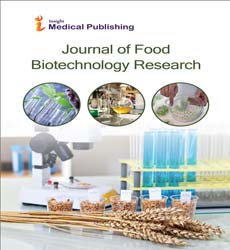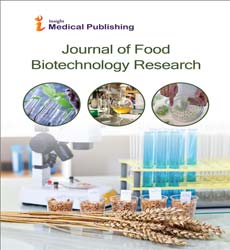Whey As A Potential Functional Food-Properties, Processing And Future Perspective
Department of Food Engineering, Laboratory for Technology of Milk and Milk products, University of Zagreb, Zagreb, Croatia
- *Corresponding Author:
- Irena Barukcic
Faculty of Food Technology and Biotechnology
Department of Food Engineering
Laboratory for Technology of Milk and Milk products
University of Zagreb, Zagreb, Croatia
Tel: +3851 4605 039
E-mail: ibarukcic@pbf.hr
Received Date: January 12, 2018; Accepted Date: January 12, 2018; Published Date: January 18, 2018
Citation: Barukcic I (2018) Whey as a Potential Functional Food–Properties, Processing and Future Perspective. Vol.2 No.1:2
Editorial
Whey originates from cheese or casein production and can be defined as a yellowish-greenish liquid that remains after casein coagulation by enzymes and/or acids [1]. Milk production and processing is increasing continuously, with cheese making being the most abundant dairy product. Consequently, there are growing amounts of the produced whey [2]. Depending on the type of casein coagulation, whey can be acid or sweet. On average whey contains approximately 93% of water and 6-7% solids. Besides the differences in acidity, the proportions of certain constituents such as calcium or the present whey protein fractions are also distinct. Nevertheless, lactose is the main constituent of the whey dry matter (70%) and recovers almost entirely from the used milk. Whey proteins, minerals, milk fat and minor components like water soluble vitamins are present in moderate to low amounts [1,3].
Generally, nitrogen components of whey have been recognized as biologically most valuable constituents and are responsible for its high potential to be regarded as functional food. Whey proteins include intact globular fractions such as thermosensitive β-lactoglobulin, α-lactalbumin, bovine serum albumin and immunoglobulins as well as thermostable fraction of proteose-peptones. In smaller quantities also lactoferrin, lactolin, transferrin and other glycosylated proteins are present. Whey proteins are characterized by an excellent amino-acid composition which contains all essential and non-essential amino acids. The ratio between sulphuric amino acids (Cys,Met) influences their bioavailability and is much higher in whey proteins than in other proteins of animal or vegetable origin. Thus, biological value of whey proteins is approximately 15% higher in comparison to egg proteins which were regarded as referent considering essential amino acid concentrations [1,4]. There is a growing number of scientific evidence confirming bioactivity of whey proteins peptides arising from whey protein hydrolysis by digestive enzymes, proteolytic microorganisms or plant proteases. Some of the most examined beneficial effects are the blood pressure lowering action, anticancerogenic, antimicrobial and antioxidative properties; immunomodulatory effects, satiety regulation and weight management, bone health protection and dermoprotective action. Very often beneficial properties of glycomacropeptide (GMP) are related to therapeutical value of whey. GMP originates from enzymatic hydrolysis of casein and is only present in sweet whey. It is characterized by absence of Phenylalanine and is often a part of preparations targeted at population suffering from phenylketonuria. Besides, GMP is also related to regulation of satiety and weight management and is beneficiary to gut microbiota [5-8]. Except the very high nutritional value, whey proteins are also characterized by excellent functional properties like solubility, foaming, emulsifying and water binding ability. Thus they are very often used as natural stabilizers, emulsifiers, foaming agents, aroma binding compounds, mineral carriers, etc. [9]. Whey is also very good source of vitamin B and folic acid. Mineral composition is the most variable parameter of the whey dry matter and can amount between 0.5 and 0.83%, depending on the method of cheese production. The most abundant minerals in whey are sodium, potassium and calcium which are present in form of salts such as chlorides, phosphates, citrates and sulphates [10].
Accordingly whey is an excellent source of functional proteins and peptides, vitamins, minerals and lactose - a sugar with low glycemic index. Thus it may be considered as functional food for various groups of consumers, targeting in the first line athletes, but also children or elderly individuals.
The main problem associated to whey is its strong polluting power due to high values (40-60 g/L) of Biochemical Oxygen Demand (BOD) and Chemical Oxygen Demand (COD; 50-80 g/L) [11] which is approximately 175 times higher than typical sewage effluent [4,12]. Consequently it is strictly forbidden to dispose whey in the environment as waste water or to spread it as a fertilizer, which was a regular practice in the past.
Owing to specific composition, whey is subject to rapid microbial spoilage and requires thermal treatment whereby whey protein denaturation and sediment formation occur. Such phenomena are undesired from the consumersˈ perspective. Thus whey is mostly used as a direct animal feed for pigs, sheep and other cattle but in relation to currently produced volumes, difficulties concerning high transportation costs might occur that make such type of utilization impractical [1,3].
In order to improve economic valorization, new opportunities have been introduced like the production of dehydrated products such as whey powder, whey protein concentrates and isolates. Very popular is also the fractionation and isolation of protein components such as α-lactalbumin (α-La) or glycomacropeptide (GMP). Large volumes of whey can be processed into bioethanol, but the production of whey-based beverages proved to be the most economical and simple way of utilization [7,9].
In conclusion, whey is nutritionally valuable coproduct with numerous potentially beneficial effects on human health. Thus the production of whey based foodstuff belongs for sure to one of key points when considering future perspective of functional food.
References
- Tratnik Lj, Božanić, R (2012) Mlijekoimliječniproizvodi (Milk and dairy products). Hrvatskamljekarskaudruga, Croatian Dairy Association, Zagreb, Croatia.
- https://store.fil-idf.org/wp-content/uploads/2017/10/2017WDSs-preview.pdf
- Jelen P (2003) Whey processing. In: Fuquay JF, Fox P (eds.).Encyclopedia of Dairy Sciences (2nd edn.), Academic Press - An Imprint of Elsevier, USA. p.2740.
- Smithers GW (2008) Whey and whey proteins-From ‘gutter-to-gold’. Int Dairy J 18: 695-704.
- Brandelli A, Daroit DJ, FolmerCorrêa AP (2015) Whey as a source of peptides with remarkable biological activities. Food ResInt 73: 149-161.
- Patel S (2015) Functional food relevance of whey protein: A review of recent findings and scopes ahead. J Funct Foods 19: 308-319.
- Smithers GW (2015) Whey-ing up the options - Yesterday, today and tomorrow. Int Dairy J 48: 2-14.
- Krol J, Brodziak A, Zaborska A, Litwińczuk, Z (2017) Comparison of whey proteins and lipophilic vitamins between four cow breeds maintained in intensive production system. Mljekarstvo 67: 17-24.
- RuannJanser, Domingues MAF, Ohara A, Gonçalves dos Santos J, Peres Brexó R, et al. (2017) Whey protein as a key component in food systems: physicochemical properties, production technologies and applications. Food Structure 14: 17-29.
- Barukčić I (2013) Optimizing efficiency of whey microfiltration and ultrafiltration by applying ceramic membranes - A dissertation. University of Zagreb, Zagreb, Croatia.
- Chatzipaschali AA, Stamatis AG (2012) Biotechnological utilization with a focus on anaerobic treatment of cheese whey: current status and prospects. Energies 5: 3492-3525.
- Mockaitis G, Ratusznei SM, Rodrigues JAD, Zaiat M, Foresti E (2006) Anaerobic whey treatment by a stirred sequencing batch reactor (ASBR): Effects of organic loading and supplemented alkalinity. J Environ Manage 79: 198-206.

Open Access Journals
- Aquaculture & Veterinary Science
- Chemistry & Chemical Sciences
- Clinical Sciences
- Engineering
- General Science
- Genetics & Molecular Biology
- Health Care & Nursing
- Immunology & Microbiology
- Materials Science
- Mathematics & Physics
- Medical Sciences
- Neurology & Psychiatry
- Oncology & Cancer Science
- Pharmaceutical Sciences
